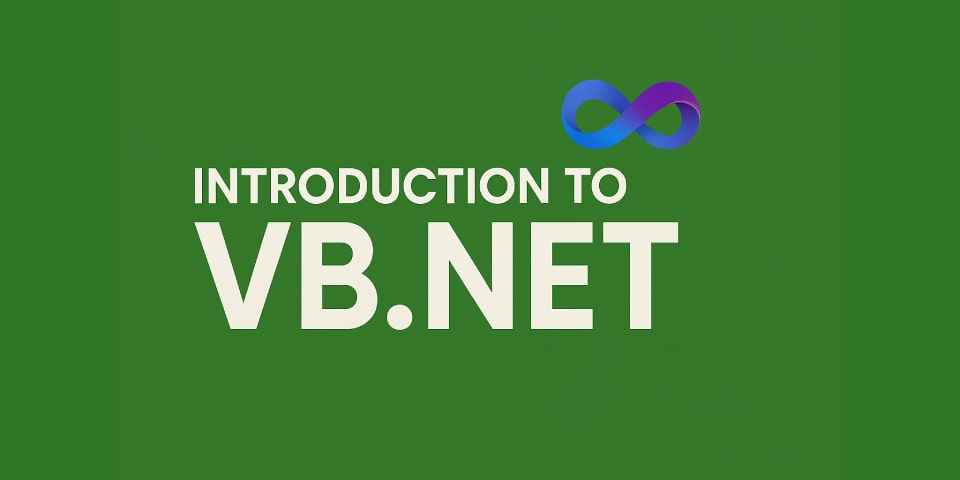
Introduction to VB.NET
Difference between ByVal and ByRef
ByVal passes a copy of the value to the procedure, so changes won’t affect the original variable.
ByRef passes a reference to the original variable, allowing it to be modified directly.
Practical example:
If you pass an object ByRef and set it to Nothing inside a Sub, it will actually be destroyed in the calling context.
Strong typing and conversions (CInt(), CStr(), TryParse)
VB.NET is strongly typed, so you must explicitly convert types when needed.
CInt(),CStr(), etc. throw exceptions if conversion failsTryParse()avoids errors by returningTrue/Falseto indicate validity
Dim numero As Integer
If Integer.TryParse("123", numero) Then
Console.WriteLine(numero)
Else
Console.WriteLine("Conversion failed")
End IfFlow control (With, Using, Select Case, Do While)
With: simplifies repeated access to object membersUsing: ensures automatic disposal of resources (e.g. files, DB)Select Case: alternative to multipleIfDo While / Do Until: loops with pre/post conditions
Using conn As New SqlConnection(connStr)
conn.Open()
'...
End UsingDifferences between Module, Class, Structure, Interface
Module: contains shared members, cannot be instantiatedClass: dynamic reference type, supports inheritanceStructure: value type, lighter, good for small dataInterface: only defines method signatures, to be implemented by concrete classes
Object-Oriented Programming in VB.NET
OOP concepts: inheritance, polymorphism, encapsulation
- Inheritance: a class can extend another (
Inherits) - Polymorphism: different objects respond to common calls
- Encapsulation: hides internal data using properties and methods
Constructors, properties, Overloading and Overriding
- The constructor (
Sub New) initializes objects - Properties (
Property) encapsulate field and access Overloads: multiple versions of a method with different parametersOverrides: redefines an inherited method
Difference between Overrides and Overloads
Overrides: used to override an inherited methodOverloads: defines multiple variants of a method with different parameters
MustInherit vs NotInheritable
MustInherit: abstract class, cannot be instantiated, may containMustOverridemethodsNotInheritable: cannot be inherited, useful for final classes
Using interfaces (Implements)
Public Interface IPrintable
Sub Print()
End Interface
Public Class Document
Implements IPrintable
Public Sub Print() Implements IPrintable.Print
Console.WriteLine("Document printed")
End Sub
End ClassCustom attributes
Attributes allow decorating classes, methods, or properties with metadata.
You can create a custom attribute by inheriting from System.Attribute.
Data Access with ADO.NET
How to connect to SQL Server?
Using conn As New SqlConnection("your_conn_string")
conn.Open()
Dim cmd As New SqlCommand("SELECT * FROM Users", conn)
Using reader = cmd.ExecuteReader()
While reader.Read()
Console.WriteLine(reader("Name"))
End While
End Using
End UsingPreventing SQL Injection
cmd.CommandText = "SELECT * FROM Users WHERE Name = @name"
cmd.Parameters.AddWithValue("@name", txtName.Text)This protects against query manipulation.
Difference between DataSet, DataTable, DataReader
DataReader: forward-only access, efficientDataTable: represents an in-memory tableDataSet: container for multipleDataTable, useful for complex operations
Debugging and Maintenance
How do you handle spaghetti legacy code?
- Analyze and understand the logic
- Gradually refactor to separate responsibilities
- Use debugger to test isolated sections
- Introduce simple patterns (e.g. Repository, Singleton)
- Write tests to prevent regressions
Debugging tools
- Breakpoints
- Watch / Autos
- Immediate Window
- Call Stack
Essential tools in Visual Studio for effective debugging.
Typical Exercises
Function that counts vowels
Function CountVowels(input As String) As Integer
Dim count As Integer = 0
For Each c As Char In input.ToLower()
If "aeiou".Contains(c) Then count += 1
Next
Return count
End FunctionPersona class with ToString()
Public Class Person
Public Property Name As String
Public Property Age As Integer
Public Sub New(name As String, age As Integer)
Me.Name = name
Me.Age = age
End Sub
Public Overrides Function ToString() As String
Return $"{Name} is {Age} years old."
End Function
End ClassDifference between Shared and Non-Shared
Shared: belongs to the class, accessible without creating an instanceNon-Shared: each object has its own copy
Useful for utility methods, e.g.: Math.Sqrt()